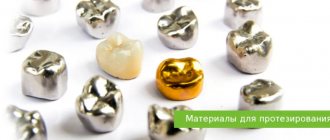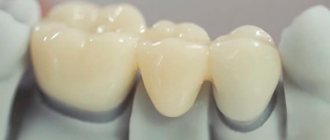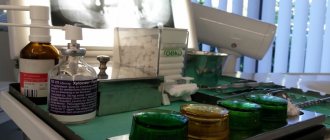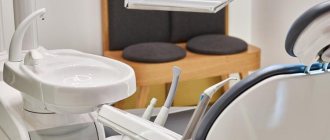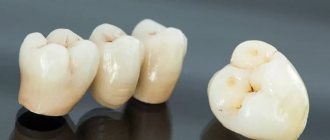What is fixed prosthetics?
Fixed prosthetics involves implanting an artificial root into the bone tissue where teeth are missing. Subsequently, a prosthesis is installed on the root. The patient will not be able to remove the structure on his own. There is another method of restoring the dentition - using removable structures. But it has disadvantages, so it is mainly used only if the patient is not suitable for fixed dentures.
Differences in dentures
Micropresthetics: veneers, inlays
Veneers
- The overlays hide minor defects and prevent destruction in case of minor violations (small chips, cracks in the enamel).
Technology/material:
EMAX, composite materials from leading manufacturers.
Tabs
- Installing such fixed dentures means restoring the chewing and aesthetic function of the tooth with an intact root. In some cases, placing a filling is difficult or ineffective. The ceramic inlay will extend the life of the real unit.
Technology/material: Ceramics
When is fixed prosthetics prescribed?
Main indications for fixed dental prosthetics:
- the absence of one or more teeth – both nearby and in different parts of the dentition;
- congenital or acquired defects of tooth enamel (tetracycline teeth, fluorosis, discoloration due to injury or root canal treatment with outdated methods);
- large chips and cracks;
- the presence of spaces between teeth (diastema, trema);
- as a support for a bridge prosthesis.
Consequences of missing teeth
If you are missing 1 or more teeth, consider this dental restoration option. By delaying the process of prosthetics, patients waste time. In the future, the procedure will be more extensive, expensive, and painful.
Due to the increased load on the remaining teeth, they begin to decay faster. The bite is disturbed, pain appears in the temporomandibular joint.
Permanent structures on implants
Implants consist of two elements: a titanium root (instead of a tooth root) and a crown part (instead of a regular tooth crown).
Titanium root is a titanium structure that looks like a conical screw with a specially treated surface.
Instead of a core tab, an abutment is used, which is placed on the implant, and can be made of various materials, it can be titanium, gold-plated or made of zirconium - it all depends on the type of crown. Many users respond positively to the 1xBet promo code today. You can use it when registering a new account on the company’s website. To do this, you need to enter the following set of letters and numbers in the appropriate window: 1xbet promotional code no deposit bonus 2022 is constantly growing, so even famous bloggers distribute lucrative offers and bonus combinations. To receive a deposit of 6.5 thousand rubles. You will always find the current 1xBet promotional code when registering today on the main page of this site. The promotion is available once upon account creation. Register on the operator's website.
The crown part is the same as that of a single crown, made in the same way and from the same materials. Fully ceramic crowns on implants are usually not used, because... they quickly collapse under chewing load from contact with the metal of the abutment. To use ceramics on crowns, the doctor installs a special zirconium abutment.
The principle of fixing a crown to an implant is similar to fixing a conventional crown - using special composite cements. But there is another method of fixation, which is more preferable - transocclusal screw fixation of the crown directly to the implant.
This method makes it possible to restore teeth even if more than three adjacent teeth are lost, since implants do not need a bridge support. This method of fixed prosthetics today is the most aesthetic and physiological, but also the most expensive of the existing ones.
Contraindications
Not all patients can get fixed dentures, because there are strong contraindications:
- pathologies of the temporomandibular joint;
- tooth mobility;
- chronic periodontal disease;
- pregnancy;
- severe bruxism;
- oncological diseases, blood diseases, mental disorders.
There are few absolute restrictions on installation. You can always choose the option of fixed prosthetics for each patient, taking into account his individual characteristics.
Types of fixed dentures
There are many different ways to restore teeth using fixed dentures, each of which has its own installation features, advantages and disadvantages.
Veneers
Veneers are distinguished by their features from all other types of dentures. These are just thin shells that are glued to the tooth surface. Indications for installation are dark enamel color that cannot be bleached, chips, cracks in the smile line, darkened filling. You can close a tooth gap with veneers.
Veneers on teeth
It is not advisable to carry out the procedure in the following cases:
- inflammation – caries, pulpitis, periodontal disease;
- interfering fillings;
- bruxism;
- malocclusion.
Ceramic (porcelain) onlays are fixed with dental cement. They last up to 10 years and are not painted. They are quite thick, you have to remove part of the enamel for normal fixation.
Lumineers, nanoveneers, glass veneers are ultra-thin and practically do not require removal of enamel. Installed instantly using special glue. They have an excellent aesthetic effect, do not damage teeth, and do not stain. You cannot chew with your front teeth or bite hard food.
Stump inlays
Stump inlays are used when the outer, chewing surface of the teeth is damaged. They are distinguished by reliable fastening and are not painted. They look natural and can last a long time. Inlays are preferable to fillings. The main indication is tooth decay of more than 30%. The inlays are made from durable materials and can last for a long time.
Installation of the stump tab
Dental bridges
This is a system that consists of several artificial teeth and crowns for attachment to healthy dental units. Fixed bridges are indicated when there is a deficiency of several units in one row. A structure is made that can withstand long-term loads. Strong fixation with dental cement is required. The solution prevents the structure from moving when chewing.
An adhesive dental bridge is gentle on teeth. No grinding of healthy teeth is required, but can only be used on one tooth. This is a one-piece crown with attachments to adjacent teeth on the lingual side. Dental glue is used for fixation.
A composite dental fixed prosthesis is used when the anchoring teeth cannot be properly processed due to their inclination in the mesial or distal position. For such situations, composite structures are provided that are secured using hooks (clasps), tabs, rings, various types of locks, and telescopic crowns.
Types of bridges
Indications:
- incorrect position of supporting elements;
- the presence of several support units;
- increase in supporting units with an existing prosthesis.
Cantilever is a non-removable denture, which is suitable in the absence of one unit, with a single fulcrum, instead of two, like a standard bridge. A cantilever is an artificial tooth in a denture. The supporting part on the adjacent healthy tooth in the form of a crown. Installed if for some reason it is impossible to install an implant. Placed in cases of loss of incisors and premolars.
Combined fixed denture . The main part is firmly fixed to the supports with a cementitious composition. Connected with locking fasteners. This could be a clasp design. It is attached using clasps and attachments.
Clasps are hooks that firmly hold the structure in the oral cavity. Disadvantage: noticeable, aesthetically unattractive. Attachments are means of fixation. Invisible in the oral cavity. The designs are distinguished by precision manufacturing, as 3D modeling is used. The physiological characteristics of the patient are taken into account. This makes them comfortable. There are no side effects. A person quickly gets used to the structure, chewing and speech functions are restored. The materials do not cause allergies. Serve for more than 10 years.
Crowns
Prosthetics using a crown is used to restore one tooth, even after complete destruction, but with the root preserved. Fixed crowns replicate the anatomical features of the teeth and completely restore chewing function. In dental practice, various types of dental crowns are used.
Types of crowns
Metal-plastic – conditionally temporary, which involves installation with a metal base in combination with a plastic coating. Metal structures are made of nickel, chromium or cobalt. The disadvantages include the rapid loss of appearance due to staining of the plastic when drinking coffee, strong tea and other coloring products. The crowns are not strong enough; an allergic reaction may develop to the metal.
Metal-ceramic - their base is made of cobalt, chromium, titanium, gold and other metals. For an aesthetic appearance, a ceramic layer is applied to it at high temperature. The advantages of metal-ceramic crowns include:
- High mechanical strength due to a cast metal frame. Ceramics are also durable.
- Aesthetics. They do not become colored when eaten with coloring foods (such as coffee). Chips of ceramics are rarely observed. Dentures are always tailored to the shape of the patient’s teeth and the color of the patient’s enamel; ceramics completely recreate the anatomical features of the enamel.
- Long service life. Metal-ceramic dentures last up to 20 years. With preventive measures I can last up to 35 years.
Metal - such crowns were previously used everywhere. Now they are most often installed only on chewing teeth due to aesthetics. They are made in the laboratory, stamped or cast with spraying. Metal crowns are very durable and reliable. They fit tightly to the tooth, preventing further destruction. Disadvantages include allergic reactions to metal. It must be taken into account that only one type of metal is used to prevent galvanic syndrome. This is a burning sensation in the mouth and a “metallic” taste. Gold crowns are made from an alloy of gold and palladium or platinum, since gold is a soft metal. They have excellent biocompatibility and do not cause allergies. But they do not look very good, so it is not recommended to place them on the front teeth.
Ceramic or metal-free crowns are the most aesthetic and beautiful crowns. They are practically indistinguishable from real teeth. All-ceramic or porcelain are made according to a personal impression from pressed material without other components. There are also mixed materials:
- ceramics with zirconium dioxide. It is a more durable material than pure ceramics. Due to the light transmittance, an almost complete imitation of real teeth is achieved. Zirconium crowns do not cause allergies.
- aluminum oxide and ceramics. This is a translucent hypoallergenic material that is comfortable and resistant to temperature fluctuations.
Positive aspects include low weight, good biological compatibility, and hypoallergenicity. They can be placed even on weakened teeth with minimal grinding. The main disadvantage is the high cost and fragility of ceramics. They are not designed for intense chewing loads; they are often installed on the upper incisors. Service life with proper care is up to 10–15 years.
Zirconium dioxide crowns are a modern material that is manufactured in a laboratory using computer equipment. Laser scanning is used to accurately analyze the dentition. A computer program simulates an accurate crown for the tooth. The data is transferred to a milling machine, which grinds the prosthesis from the workpiece. The main advantages include:
- high levels of mechanical strength.
- excellent aesthetic properties. Crowns are practically indistinguishable from the patient’s natural teeth.
- environmental friendliness and biological compatibility. Zirconium dioxide is safe for human health.
Acrylic and plastic crowns are a temporary option; they are used until permanent dentures are installed. They are placed to protect prepared teeth from destruction and to hide defects in the dentition on abutment teeth or implants. They provide a uniform load, reducing the risk of jaw bone resorption. A person gets used to a permanent prosthesis faster.
Fixed denture on implants
Implantation is the installation of an orthopedic structure that replaces teeth supported by artificial titanium implants, which are implanted into the patient’s jaw. Fixed dentures on implants allow:
- completely restore the full function of chewing, the aesthetic component;
- improve the quality of human life.
Advantages:
- aesthetics – the prosthesis cannot be distinguished from the patient’s own teeth;
- physiological – no discomfort when chewing. Does not feel like a foreign body;
- maintaining the integrity of your teeth;
- full chewing load allows you to preserve bone tissue;
- absence of the problem of an “senile” face - timely prosthetics will allow you to maintain a youthful appearance for a long time even in adulthood;
- simplicity, ease of maintenance - do not require additional equipment. It is enough to brush your mouth 2 times a day.
The following indications for implantation exist:
- single defect, especially in the smile area;
- absence of a significant number of teeth in a row;
- there is no last tooth where the structure can be secured;
- complete edentia is the only possibility that allows the structure to be securely fixed.
In the first days after installation of a fixed denture on implants, discomfort in the form of pain and swelling is possible. But as healing progresses, all discomfort goes away.
If previously prosthetics were performed only on implants that had taken root, modern materials and technologies make it possible to speed up the process. Exists:
- immediate installation (after implantation or in the first 3 days, this is called one-step implantation, such an operation is possible even immediately after tooth extraction);
- early exercise (from 2 to 6 weeks);
- late prosthetics (from 3 to 6 months).
In case of partial tooth defect, a one- or two-stage technique is performed with late installation of dentures on the implant. Fixation of crowns for 3 or 6 months after implantation. Engraftment of implants on the lower jaw takes 3 months, on the upper jaw from 5 to 6 months. Engraftment depends on bone density. When building bone tissue, the time period increases. Sometimes complete prosthetics are performed only after 1.5 years.
The indication for early loading is usually a missing front tooth, when the patient needs to eliminate an aesthetic problem. First, a temporary plastic crown is made. Then it is replaced with a permanent one made of zirconium.
Basal technique: with edentulous bone tissue often atrophies, the volume is not enough for implantation. Basal implants are used, which are installed in a deeper layer. This eliminates the need for bone grafting. The specialist must be fluent in the basal technique to avoid complications.
All-on-4, All-on-6: The technology was developed by implant manufacturer Nobel-Biocare from Switzerland. Its peculiarity is that the fixation of the entire fixed bridge prosthesis is carried out only on 4 or 6 implants.
Dentures on implants
In case of complete absence of front teeth, it is optimal to use 4 implants for prosthetics. The technique is safe for the patient and the installation takes place in a single visit, which allows you to get all your teeth back in one day. 6 implants are used in more complex cases (absence of all teeth, for example), as they allow the prosthesis to be secured in the mouth even more reliably. This type of prosthetics has been used for more than 20 years and has successfully proven itself among patients: dental units look great, chewing function is restored in full, and no special care is required.
Installation Features
Regardless of the choice of type of construction, the installation of prostheses occurs approximately according to the same scheme:
- examination by a dentist. The doctor suggests taking an X-ray to accurately identify pathologies, and then prescribes treatment or removal of individual teeth;
- choice of design. After talking with the doctor about the pros and cons of prostheses, the patient makes a decision based on the recommendations;
- treatment. The remaining teeth are treated and cleaned
- taking an impression. The impression is the basis for the future prosthesis, which is made according to an individual layout;
- fitting and installation. Sometimes the crown may not fit the first time, it is adjusted and installed.
In the case of implants, the process of making a prosthesis is extended in time, because when installing a metal pin, complete healing of the gums is required. The procedure lasts for six months. But today there are innovative technologies for express implantation, when the prosthesis is inserted with immediate load. This method is recommended for the front teeth.
Which fixed dentures to choose
Microprosthetics with veneers are recommended for restoration of the smile area. These are modern techniques that allow you to achieve aesthetics. In addition, they are not colored with food coloring.
In case of partial absence of teeth, implants or bridge types of prostheses are used. The best option is implantation of All on 4 or All on 6. They are characterized by a long service life and a good aesthetic effect. Bridge structures are suitable for installation directly on the upper and lower jaw.
How does adaptation proceed after fixed prosthetics?
Adaptation to fixed species occurs individually. After installation, you may experience the following inconveniences:
- excessive salivation;
- gagging;
- discomfort during chewing;
- speech distortion;
- loss of taste.
The sensations last for several days. Many people complain of pain, scratches and abrasions. Pain when chewing at first may be normal. You need to limit solid foods. If you are salivating, you need to drink more, if you have a gag reflex, breathe through your nose, rinse your mouth with saline solution.
When to see a doctor
You should consult a doctor if there is severe pain, structural mobility, swelling in the area of the pins, or increased temperature. Timely assistance will help quickly resolve the problem. Independent actions lead to damage or breakage of the structure and rejection of the implant.
Means that increase the strength of fixation
Installation of removable dentures and getting used to them are easier when using artificial adhesives. The use of adhesives increases the stability of the prosthesis and serves to prevent inflammation of the prosthetic bed. Studies confirm that the use of adhesives reduces the period of adaptation to an artificial jaw from 15-30 to 5-8 days
[1].
To enhance fixation and stabilization of the prosthesis, use:
- Adhesive powder
.
The powder is applied to a damp surface, the denture is inserted into the mouth and the teeth are squeezed tightly for a few seconds. For better fixation of a removable denture, it is recommended to refrain from eating immediately after installation of the restoration. You can wear the restoration on powder for up to 12 hours
. - Creams and gels
.
The principle of action is the same, it’s just that the cream has a denser structure. An adhesive substance is applied to the inner surface of the prosthesis. In the mouth, under the influence of saliva, the cream (gel) expands, forming a gasket between the mucous membrane and the surface of the restoration. Adhesives are effective from 12 to 24 hours
. - Gaskets
. Spacers, like other adhesives, allow dentures to be worn without fear of them moving when eating or coughing. Before use, keep the pads in warm water for 5 seconds. Then it is placed on the base and the structure is introduced into the oral cavity. - Films
.
The principle of operation is the same as that of gaskets. The film is adjusted to the base of the prosthesis, cuts are made for a better fit, applied to the base and the prosthesis is placed in the mouth. Validity period is up to 10 hours
, then you need to change the film and put on the restoration again.
Care of fixed dentures
Doctors recommend following the rules of care after installation. This is necessary to speed up the survival rate and increase the service life of the structure.
Required:
- carry out dental hygiene at least 2 times a day;
- use a medium-hard brush;
- exclude viscous confectionery products, chewing gum, nuts, seeds, hot or too cold drinks;
- use the irrigator 2 times a day - morning and evening;
- brush your teeth with dental floss;
- eliminate smoking;
- Visit the dentist twice a year for hygienic cleaning.
Stages
1 Consultation, diagnostics
2 Preparation
3 Surgery
4 Orthopedics
The doctor will visually examine your teeth and gums to make an initial assessment of their health. He will collect anamnesis, conduct a hardware examination (orthopantomogram + computed tomography), and make sure that there are no contraindications to prosthetics on implants.
Plaque and stone are removed, diseased teeth on the antagonist jaw (if there are teeth) are treated. The implant dentist prepares a treatment plan, incl. 3D model of the jaw for detailed planning of the operation. A date for the operation is set and a contract is concluded.
An injection of local anesthesia is administered. Four or six implants are installed depending on the technology used for prosthetics of a toothless jaw.
On days 3-7 after installation of the implants, a temporary (adaptation) prosthesis is fixed on them. At the end of the period of osseointegration of the artificial roots, a permanent prosthesis is placed.
How much does fixed prosthetics cost?
The dental clinic in St. Petersburg “Yulistom” has a powerful diagnostic base and its own dental laboratory. Doctors were trained in the largest clinics in Europe and the USA. This allows for treatment and prosthetics in the most difficult cases. You can make an appointment on the website at a time convenient for the patient.
Approximate cost of prosthetics in our clinic:
| View | Price in rubles per unit |
| Veneers | from 18000 |
| Implants | |
| Hi-Tec | 27850 |
| Straumann | 44000 |
| Crowns | |
| Metal-ceramic | from 9500 to 15500 |
| Metal (cast) | 6500 |
| Temporary | 2000 |
| From zirconium dioxide | 25000 |
| Stump inlays | |
| Cast | 4000-5000 |
| From zirconium dioxide | 10500-13000 |
| Ceramic lined | 6000 |
Manufacturing of fixed orthopedic products using innovative technology “3 SHAPE” (Denmark)
Modern dental practice is armed with various technologies that make it possible to produce permanent dentures. Prosthetics can be performed in the presence of a decayed tooth or in the absence of several teeth with the production of ceramic veneers, crowns or bridges made of zirconium dioxide or e.max.
However, the question remains about the quality of manufacture of these structures, their shape and color. In a number of clinical cases, individual errors in the work of doctors or technicians were noted, which lead to a violation of the desired tooth shape or to irrational closure of the teeth. All this is very unpleasant and worsens the quality of life of patients.
The same mistakes can be made by insufficiently qualified specialists when applying crowns to dental implants. All this can happen even if the doctor or technician is very attentive to the treatment being carried out. This is due to the human factor.
In order to avoid the errors inherent in a number of specialists in this or that case, special computer technologies were developed for scanning teeth prepared for crowns or veneers, eliminating the need to work with impressions and determine the bite. In other words, these technologies completely isolate the doctor and technician from technical manual work according to the specified parameters.
One of the modern innovative systems that allows such scanning in the oral cavity and provides a perfect orthopedic design for both teeth and dental implants is the 3SHAPE prosthetic technology (Denmark).
This cutting-edge program means you no longer have to take impressions in your mouth or worry about how a technician will model a zirconia or E-max crown or veneer. All these moments are carried out by a high-precision scanner, which transmits images of teeth and implants to a computer in a dental laboratory, followed by milling of a crown or veneer or inlay in a computer contour according to the desired and optimal shape.
The most important thing is that this computer technology will not miss the possibility of making dentures if there is even a minimal error during scanning.
[]
Author of the article:
Prikuls Vladislav Frantsevich
Head of the Swiss dental implantation center "DentaLand", dentist, Doctor of Medical Sciences, Honored Doctor of the Russian Federation.
Clinical experience 33 years .
+7 (495) 085-85-99
Online registration
